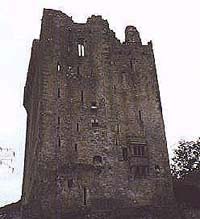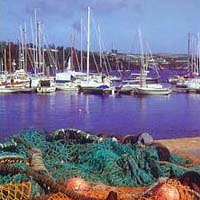Vacation Guide
Ireland golf vacation guide : To do and see
CORK
 Blarney Castle and Stone – situated in the town of Blarney, just northeast of Cork City is Blarney Castle. Tradition dictates that those in search of the gift of the gab had to kiss a certain stone, situated high in the battlements of Blarney Castle and known throughout the world as the "Blarney Stone". Built in 1446, Blarney Castle successfully resisted a number of sieges throughout the 16th and 17th century until finally captured in 1690 by the army of King William III.
Blarney Castle and Stone – situated in the town of Blarney, just northeast of Cork City is Blarney Castle. Tradition dictates that those in search of the gift of the gab had to kiss a certain stone, situated high in the battlements of Blarney Castle and known throughout the world as the "Blarney Stone". Built in 1446, Blarney Castle successfully resisted a number of sieges throughout the 16th and 17th century until finally captured in 1690 by the army of King William III.
Charles Fort – indicating the past military significance of Kinsale, Charles Fort, located just outside the town, was built in the early 1680’s and is a classic example of a star-shaped fort. Besieged by the Duke of Marlborough in 1690, it was eventually destroyed in 1922 during the Irish Civil War.
Clock Gate – straddling the main thoroughfare of Youghal Town and built in 1777 as a replacement for the mediaeval Iron Gate that separated the upper and lower towns, the Clock Gate served as a town jail until 1887. Incapable of holding large numbers of prisoners from the revolution, for a time, a policy was instituted of hanging rebels from the windows as an example to the rest of the population.
Clonakilty – situated in an area of immense beauty, southwest of Cork City, this was the birthplace of Irish patron Michael Collins and is home to the West Cork Regional Museum, which graphically illustrates the role that Collins played in the Irish War of Independence.
Cobh Heritage Centre – the heritage town of Cobh, known as Queenstown until 1922, was Ireland’s main point of departure for the New World during the 19th century, with over two million people setting sail for America from Cobh between 1845 and 1860. The Heritage Centre reconstructs the scenes from this era with a touching collection of letters, photographs and other memorabilia. The town was also the last port of call for the ill-fated ship, Titanic, in 1913.
Cork City – built on the banks of the River Lee, Cork is Ireland’s third largest city behind Dublin and Belfast and originally developed around a 7th century monastic settlement. Known as the "Rebel County", Cork has shown fierce resistance to British rule over the years. There are many fine examples of architecture through the city, while as a shopping haven the city is hard to beat.
Desmond Castle – situated in the town of Kinsale, Desmond Castle was built as a custom house in 1500, was occupied by the Spanish in 1601 and became known as the French Prison, after a fire in which 54 prisoners (mainly French sailors) died in 1747. Used to hold American prisoners during War of Independence, it has since been converted into an International Wine Museum.
Fota Arboretum and Gardens – lying about ten miles east of Cork City, the Fota Arboretum and Gardens boast a renowned collection of rare trees, shrubs and sub tropical plants from China, South America, the Himalayas and the Far East.
 Fota Island Wildlife Park – located ten miles east of Cork City, this 16-acre wildlife park, owned by the Royal Zoological Society of Ireland, has more than seventy species of wildlife in open surroundings, with monkeys swinging from tree to tree on lake islands and kangaroos leaping around extensive grasslands.
Fota Island Wildlife Park – located ten miles east of Cork City, this 16-acre wildlife park, owned by the Royal Zoological Society of Ireland, has more than seventy species of wildlife in open surroundings, with monkeys swinging from tree to tree on lake islands and kangaroos leaping around extensive grasslands.
Garinish Island – this miniature island paradise was designed in the 1920’s by a celebrated garden architect who integrated a whole range of new exotic species such as bamboo, magnolias and rare conifers into the Italian gardens. In 1953, the magnificent ensemble was bequeathed to the Irish people.
Glengarriff – this small village is one of the most scenic locations in Ireland. Palm trees and subtropical flowers confirm the mildness of the climate, while nearby Glengarriff Forest Park is a haven for oak, beech and birch trees and wildlife such as foxes, stoats, deer, squirrels and badgers.
Gougane Barra – set amid magnificent mountain scenery close to Glengarriff, this little village is a truly magical place where brooding cliffs rise high above the lakes dark waters. It is believed that St. Finbarr, the patron saint of Cork, once had his hermitage here.
James Fort – another example of Kinsale’s past military importance, James Fort was constructed in 1607 and is an excellent example of 17th century military architecture. Standing opposite Charles Fort at the entrance of the harbour, it was captured by the Williamite forces in 1690.
 Kinsale Town – can trace its origins back to 1177 but claims its prominence in Irish history for the battle between the Irish – Spanish alliance and the English armies. Following this defeat, old Irish society effectively came to an end as the country became increasingly Anglican. Kinsale offers many attractions including Desmond Castle and St. Melrose’s Church. The town also boasts an international reputation as a centre for gastronomic excellence.
Kinsale Town – can trace its origins back to 1177 but claims its prominence in Irish history for the battle between the Irish – Spanish alliance and the English armies. Following this defeat, old Irish society effectively came to an end as the country became increasingly Anglican. Kinsale offers many attractions including Desmond Castle and St. Melrose’s Church. The town also boasts an international reputation as a centre for gastronomic excellence.
Myrtle Grove – located in Youghal in southeastern Cork, Myrtle Grove was the mansion home of Sir Walter Raleigh who is said to have introduced tobacco and the potato to Ireland during the 16th century. Myrtle Grove is an excellent example of a country mansion with fine landscaped gardens.
St. Colman’s Cathedral – dominating the town of Cobh, this impressive cathedral was only completed in 1915, having taken 47 years to build. It boasts a 300-foot spire and a carillon of forty-nine bells, the largest of its kind in Ireland. The interior is highly decorated with carved panels of Bath stone as well as some spectacular stained-glass windows.
The Gearagh (Wooded River Valley) – situated outside the town of Macroom, this is one of the area’s principal attractions. A wildlife reserve containing the only post-glacial alluvial oak forest remains in Europe, it features a series of submerged islands and an abundance of wildlife.



